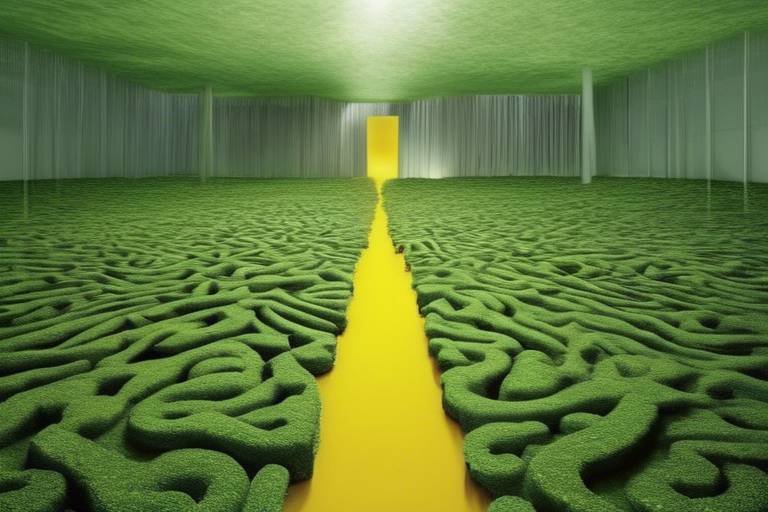The Rich Tapestry of Indigenous Australian Art
Indigenous Australian art is a vibrant and diverse tapestry that weaves together ancient traditions, cultural symbolism, and contemporary expressions. This rich artistic heritage reflects the deep connection of Indigenous peoples to their land, stories, and spiritual beliefs. From traditional techniques passed down through generations to modern interpretations that challenge conventions, Indigenous Australian art continues to captivate and inspire audiences around the world.

Traditional Indigenous Art Techniques
The art of Indigenous Australians is a vibrant reflection of their rich cultural heritage and spiritual connection to the land. Through intricate designs, vibrant colors, and profound symbolism, Indigenous art tells stories that have been passed down through generations, capturing the essence of ancient traditions and contemporary struggles.
Traditional Indigenous art techniques are deeply rooted in the cultural practices and beliefs of Aboriginal and Torres Strait Islander peoples. One of the most iconic methods used is dot painting, where artists meticulously apply dots of various colors to create intricate patterns and symbols. This technique is not only visually striking but also holds deep spiritual significance, representing connections to the land, ancestors, and Dreamtime stories.
Another traditional technique is cross-hatching, commonly seen in bark paintings. Artists use fine lines to create geometric patterns that convey stories and cultural knowledge. Natural materials such as ochre, clay, and plant extracts are often used to produce earthy tones that are characteristic of Indigenous art.
Indigenous artists also utilize carving and sculpting to create three-dimensional artworks, such as wooden sculptures and ceremonial objects. These intricate carvings often depict animals, totems, and ancestral beings, embodying the interconnectedness of the natural and spiritual worlds.
Furthermore, weaving and textile art are essential components of Indigenous cultural expression. Intricate patterns and designs are woven into baskets, mats, and clothing, showcasing the skill and creativity of Indigenous artisans. These textiles not only serve practical purposes but also carry symbolic meanings related to identity, kinship, and storytelling.
Overall, traditional Indigenous art techniques are a testament to the ingenuity and creativity of Indigenous Australian artists, preserving cultural traditions and stories through visually captivating and spiritually significant artworks.

Symbolism and Storytelling in Indigenous Art
Indigenous Australian art is a rich tapestry woven with symbolism and storytelling, reflecting the deep connection between the artists, their culture, and the land. Every stroke of the brush, every dot meticulously placed, carries layers of meaning that transcend mere aesthetics. Symbols in Indigenous art are not just decorative elements but hold profound spiritual significance, often representing ancestral stories, totems, and sacred rituals.
Storytelling is at the heart of Indigenous art, serving as a means of passing down knowledge, history, and cultural traditions from one generation to the next. Each artwork is a visual narrative, a window into the collective memory of a community, preserving ancient stories and teachings that might otherwise be lost to time. Through intricate patterns and intricate designs, Indigenous artists communicate complex narratives that speak to the essence of their identity and worldview.
Moreover, the use of symbols in Indigenous art goes beyond mere representation; it embodies a spiritual connection to the land, animals, and celestial beings. The Dreamtime, a fundamental concept in Indigenous Australian belief systems, is often depicted through symbols that convey the interconnectedness of all living things and the eternal nature of creation. These symbols serve as a visual language through which artists communicate with the spiritual realm and pay homage to their ancestors.
By delving into the symbolism and storytelling woven into Indigenous art, we gain a deeper appreciation for the cultural richness and spiritual depth embedded in every brushstroke and carving. It is through these artistic expressions that Indigenous communities assert their identity, resilience, and enduring connection to the land that has shaped their existence for thousands of years.

Contemporary Indigenous Art Movements
Contemporary Indigenous art movements in Australia have seen a remarkable evolution in recent decades, reflecting the intersection of tradition and innovation. Artists today are not only carrying forward the rich cultural heritage of their ancestors but also experimenting with new techniques and mediums to express their unique perspectives.
One prominent aspect of contemporary Indigenous art is the fusion of traditional motifs with modern artistic styles, creating a dynamic visual language that resonates with both Indigenous and non-Indigenous audiences. This blending of old and new allows for the reinterpretation of ancestral stories and symbols in a contemporary context, keeping the cultural narratives alive and relevant.
Moreover, contemporary Indigenous artists are increasingly using their art as a platform to address pressing social and political issues, such as environmental conservation, social justice, and cultural resilience. Through their creations, these artists challenge stereotypes, confront historical injustices, and assert their presence in the global art scene.
Collaborations between Indigenous and non-Indigenous artists have also become more common, fostering cross-cultural dialogues and pushing the boundaries of artistic expression. These partnerships not only promote cultural exchange but also contribute to the recognition and appreciation of Indigenous art on a broader scale.
Furthermore, the digital age has opened up new avenues for Indigenous artists to showcase their work to a global audience, breaking down geographical barriers and reaching art enthusiasts worldwide. Online platforms and social media have become powerful tools for promoting Indigenous art and connecting artists with collectors and admirers from diverse backgrounds.
In conclusion, contemporary Indigenous art movements in Australia embody a vibrant tapestry of creativity, resilience, and cultural pride. By embracing innovation while honoring tradition, Indigenous artists continue to shape the artistic landscape and challenge perceptions, making a significant impact on the art world at large.

Impact of Colonization on Indigenous Art
Colonization has had a profound impact on Indigenous Australian art, shaping its trajectory and evolution over time. The arrival of European settlers in Australia brought significant changes to the traditional practices and artistic expressions of Indigenous communities. The imposition of Western ideologies and artistic styles led to a suppression of Indigenous art forms, as they were often dismissed as primitive or inferior.
Furthermore, the disruption caused by colonization resulted in the loss of many artistic techniques and cultural knowledge that had been passed down through generations. Indigenous artists faced challenges in preserving their traditional practices and struggled to find ways to adapt to the new cultural landscape imposed by colonizers.
Despite these adversities, colonization also sparked a sense of resilience and determination among Indigenous artists. Many began to incorporate elements of Western art into their work while still maintaining their cultural identity and storytelling traditions. This fusion of styles gave rise to new forms of Indigenous art that reflected both the struggles and resilience of Indigenous communities in the face of colonization.
Additionally, colonization brought about a shift in the themes and subjects depicted in Indigenous art. Artists began to explore issues such as displacement, loss of land, and cultural identity in response to the impact of colonization on their communities. These themes became central to the narrative of Indigenous art, serving as a powerful means of resistance and resilience against the forces of cultural assimilation.
Today, the legacy of colonization continues to influence Indigenous Australian art, as artists navigate the complexities of preserving their cultural heritage while engaging with contemporary art practices. The impact of colonization on Indigenous art serves as a reminder of the resilience and creativity of Indigenous artists in the face of historical trauma and cultural erasure.

Role of Indigenous Art in Cultural Identity
Indigenous Australian art serves as a powerful medium for preserving and asserting the cultural identity and heritage of Indigenous communities. Through intricate patterns, vibrant colors, and symbolic representations, Indigenous art encapsulates the stories, traditions, and spiritual beliefs passed down through generations. It acts as a visual language that connects individuals to their ancestors, land, and Dreamtime.
Moreover, Indigenous art plays a crucial role in fostering a sense of belonging and pride among Indigenous peoples. It serves as a form of cultural expression that transcends language barriers, allowing artists to communicate their history and worldview to a global audience. The art not only reflects the diversity of Indigenous cultures but also unites communities in celebrating their shared heritage.
By creating and showcasing their art, Indigenous artists reclaim agency over their narratives and challenge dominant narratives imposed by colonization. This act of self-representation empowers Indigenous individuals to assert their cultural autonomy and resist the erasure of their identities. Through art, Indigenous communities reaffirm their presence, resilience, and ongoing connection to their ancestral lands.
Furthermore, Indigenous art serves as a bridge between the past, present, and future, ensuring that traditional practices and stories are preserved for future generations. It acts as a living archive of Indigenous knowledge and wisdom, offering insights into the history, values, and experiences of Indigenous peoples. The art not only honors the legacy of those who came before but also inspires younger generations to embrace their cultural heritage with pride.
Overall, Indigenous art is not merely a visual spectacle but a cornerstone of cultural identity, resilience, and resistance for Indigenous Australian communities. Its significance lies in its ability to transcend time and space, weaving together the intricate threads of tradition, spirituality, and creativity into a rich tapestry that embodies the essence of Indigenous cultures.

Indigenous Art as a Form of Resistance
Indigenous Australian art is not merely a form of creative expression; it is a powerful tool for resistance against historical injustices and ongoing marginalization. Through their art, Indigenous artists assert their cultural identity, challenge dominant narratives, and reclaim their stories from a colonial past that sought to erase them.
One of the most striking aspects of Indigenous art as a form of resistance is its ability to subvert mainstream expectations and disrupt the status quo. By incorporating traditional symbols, motifs, and techniques into their work, Indigenous artists assert their presence and resilience in the face of cultural appropriation and erasure.
Moreover, Indigenous art serves as a platform for activism and social commentary, addressing issues such as land rights, environmental degradation, and social inequality. Through their creations, artists communicate powerful messages that resonate far beyond the confines of the art world, sparking conversations and inspiring change.
Furthermore, Indigenous art as a form of resistance is deeply rooted in the concept of cultural sovereignty. By asserting their right to self-determination and cultural autonomy through their artistic practices, Indigenous artists reclaim agency over their heritage and challenge the narratives imposed upon them by external forces.
In essence, Indigenous art as a form of resistance is a testament to the enduring strength and resilience of Indigenous communities in the face of adversity. It is a defiant declaration of cultural survival, a celebration of heritage, and a call to action for a more inclusive and equitable future.

Indigenous Art in the Global Art Market
Indigenous Australian art has transcended borders and captured the attention of the global art market with its rich cultural heritage and unique storytelling. The global art scene has increasingly recognized the value and significance of Indigenous Australian art, leading to a surge in demand and appreciation for these artworks.
Art collectors and enthusiasts worldwide are drawn to the authenticity and spiritual depth conveyed through Indigenous art forms. The intricate patterns, vibrant colors, and symbolic motifs tell compelling stories of connection to land, ancestors, and Dreamtime narratives, resonating with audiences beyond Australia's shores.
Indigenous Australian artists are gaining international acclaim for their exceptional talent and ability to merge traditional techniques with contemporary styles, creating a fusion that appeals to a diverse range of art lovers. The global art market serves as a platform for these artists to showcase their work and share their cultural heritage with a broader audience.
However, the commercialization of Indigenous Australian art has also raised concerns about cultural appropriation and exploitation. It is crucial for artists to maintain ownership and control over their narratives and ensure that their cultural heritage is respected and preserved in the global art market.
Despite the challenges, the increasing visibility of Indigenous Australian art on the global stage presents opportunities for artists to gain recognition, generate income, and foster cross-cultural understanding. By navigating the complexities of the art market while staying true to their roots, Indigenous artists continue to make a significant impact on the global art scene.

Challenges and Opportunities for Indigenous Artists
Indigenous Australian artists face a myriad of challenges in their pursuit of showcasing their unique cultural heritage through art. One of the primary obstacles is the limited access to resources and funding, which hinders their ability to create and exhibit their work on a larger scale. Additionally, the lack of recognition and appreciation for Indigenous art in mainstream art circles poses a significant challenge, leading to underrepresentation and marginalization of these talented artists.
On the other hand, there are also opportunities emerging for Indigenous artists to break through these barriers and thrive in the art world. Initiatives such as artist residencies, mentorship programs, and collaborative projects provide avenues for skill development, networking, and exposure to a broader audience. Moreover, the growing interest in Indigenous art both locally and internationally offers a platform for artists to share their stories, traditions, and perspectives with a global audience, creating opportunities for cultural exchange and dialogue.
Despite the challenges, Indigenous artists continue to navigate the art landscape with resilience and creativity, finding innovative ways to preserve their cultural heritage and challenge stereotypes through their art. By seizing the opportunities available and advocating for greater recognition and support, Indigenous artists are carving out a space for themselves in the art world, asserting their presence and contributing to the rich tapestry of artistic expression.
Frequently Asked Questions
- What is Indigenous Australian art?
Indigenous Australian art refers to the artistic traditions and practices of Aboriginal and Torres Strait Islander peoples. It encompasses a wide range of visual arts, including painting, sculpture, weaving, and ceremonial objects, that reflect the rich cultural heritage and spiritual connections of Indigenous communities.
- What are some common themes in Indigenous Australian art?
Common themes in Indigenous Australian art include Dreaming stories, ancestral connections, land and nature, spirituality, and cultural identity. These themes are often expressed through intricate symbols, patterns, and colors that carry deep meanings and narratives passed down through generations.
- How has colonization impacted Indigenous Australian art?
Colonization has had a profound impact on Indigenous Australian art, leading to the loss of traditional practices, cultural suppression, and the appropriation of Indigenous artistic motifs. Despite these challenges, Indigenous artists have used their art as a form of resistance and cultural revitalization in the face of adversity.
- Is Indigenous Australian art only traditional, or does it also include contemporary forms?
While Indigenous Australian art has deep roots in traditional practices and techniques, it has also evolved to encompass contemporary forms of expression. Many Indigenous artists today incorporate modern materials, styles, and themes into their work, reflecting the dynamic nature of Indigenous art in response to changing social and cultural landscapes.
- How can I support Indigenous Australian artists and their communities?
You can support Indigenous Australian artists by purchasing their artworks from reputable sources, attending exhibitions and cultural events, learning about the cultural significance of their art, and advocating for the recognition and respect of Indigenous artistic practices. By engaging with and valuing Indigenous art, you contribute to the preservation and celebration of Indigenous cultural heritage.



















